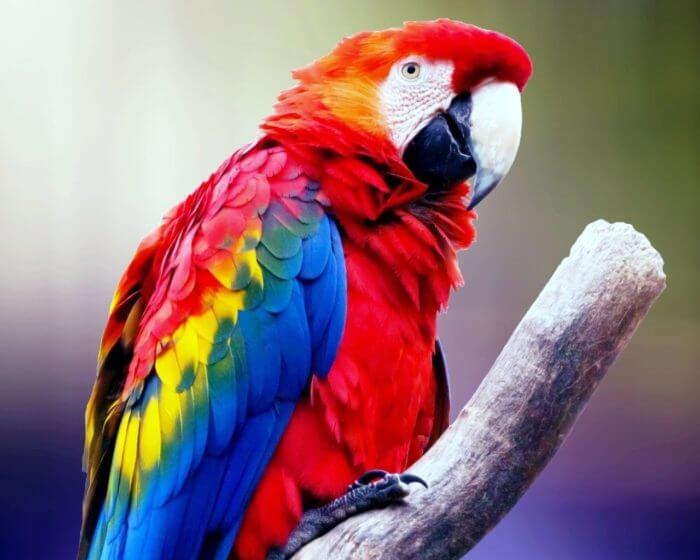Have you lost your heart to the majestic macaws? No wonder: for many, the imposing birds are the epitome of parrots. With their beauty and intelligence, trustworthiness, and playfulness, it is easy for the animals to cast a spell on people. Parrot lovers know, however, that to enable the macaw parrot a species-appropriate life, a lot of effort and empathy are necessary.
Macaw Parrot: Sensitive Animals for Experts

Macaws are native to the rainforests of Central and South America, where outside of the breeding season they roam in sociable flocks of around ten to twenty animals. Their range of action when searching for food is several kilometers. The habitat of the macaw parrots is shrinking, not least due to overexploitation and human settlements. Macaws form lifelong pairs and show very differentiated social behavior among themselves in the group. For the macaw as a pet, this means: it must have a partner – otherwise there will inevitably lead to behavioral disorders such as the dreaded feather plucking or incorrect imprinting on people. However, it will never even begin to replace a conspecific for a macaw parrot.
The Macaw Parrot and the Attitude
A bird as large as a macaw needs one thing of all things when keeping pets: space. This means that you have to offer your animals an aviary or a bird room. Accommodation should only be used for temporarily unavoidable security or as sleeping quarters. It must be very large: the bird should not bump a feather on either side with its wings outstretched. The macaw parrot size is an average of 90 centimeters in length and has a wingspan of around 90 to 115 centimeters. As they usually interact freely, many macaws develop intimate relationships with their owners. The availability of changing activities materials and toys is important for the equilibrium of the birds.
Red, Yellow, Green – the Different Macaw Parrots
There are eight subspecies within the macaw family that differ in their coloration.
The most famous representatives are:
- Scarlet macaw: red basic plumage, blue flight, and tail feathers, yellow wing spot, light beak.
- Yellow and breasted Macaw: plumage on chest and undersides of wings yellow, the upper surface of body blue, dark beak, black throat.
- Green-winged macaw: basic plumage red, wing and tail feathers blue, green wing cover, light beak.
What all macaws have in common is the sparsely feathered face mask with an individual stripe pattern on a white background.
Fruit Salad is the Trump Card: the Macaw’s Menu
In the lush vegetation of its natural habitat, the macaw finds a rich supply of buds, fruits, and nuts – the bird’s diet is therefore quite frugal and is supplemented by suitable parrot feed mixtures in pet husbandry. With its large, strong beak, the bird can perfectly crack seeds and portion fruit, using its claws as a gripping tool. To keep the beak busy, offer the macaws fresh twigs and wood to nibble on. However, you shouldn’t feed unshelled peanuts: There is a risk of mold spores getting into the parrot’s lungs.
Do Macaw Parrots Get Used to Humans?
Macaws are intelligent and curious animals that also have a natural ability to imitate voices and sounds. They become quite tame, can be petted, and learn little tricks if you steer the birds’ playful mood in the right direction. The facility can suffer from the bird’s great beak strength. A thorough basic education for macaws in the human household is therefore absolutely necessary – the intelligent animals quickly learn what is wanted and forbidden.
Macaw

Origin
Middle and South America;
Size
80 – 90 centimeters;
Weight
Up to 1.4 kilograms;
Appearance
(Almost) featherless face mask, slender body, long tail, broad head with a strong beak;
Plumage
Depending on the subspecies green, red, or yellow basic plumage with different colored wing and tail feathers;
Life expectancy
Realistic age around 40 years, ninety-year-old animals are documented;
Temperament
Intelligent, demanding, sensitive, jealous.
